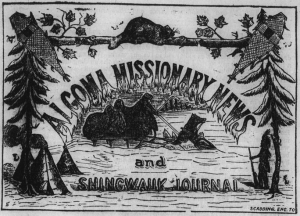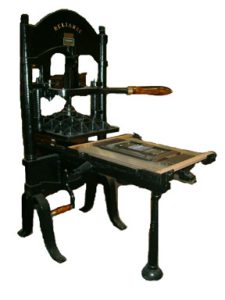7 Print Shop
During the late 19th century, the Shingwauk Residential School operated on the Industrial school model where students spent part of their time at school work and part of their time learning a trade. These trades usually supported the school in some way and included farming, carpentry, bootmaking, tailoring, printing, blacksmithing, and more. Some of these trades were taught on school grounds, with the shops part of the building complexes, while some other trades were apprenticed in the town. From 1876 until 1883 Shingwauk operated its own print shop where students learned the trade by printing Algoma Missionary News and The Peace Pipe.
Four boys apprenticed in the shop, with two of them working at a time on alternate weeks. The week they were not in the print shop was spent in class. Generally, they started their apprenticeship after being at Shingwauk for 2 years. The first four boys to work in the print shop were David McGrah age 13, William Sahguhcheway age 14, Willie Riley age 12, and John Rodd age 13. When the shop first opened, there was no professional teacher to show the boys what to do, it was just the Principal Rev. E. F. Wilson who was also learning as he went along. The boys worked to fold and sew the papers for the magazine together, sometimes working long hours in order to get the issues out on time. The winter of 1877 was so cold that the boys had to work all through the night to finish printing otherwise the printing press and other equipment would freeze over. The type originally used in the first small printing press, as well as the AMN frontpiece, were carved in the carpentry shop by carpentry apprentice Adam Kiyoshk.

In 1877 Rev. Wilson bought a more professional printing press and equipment from a local shop which was closing down. This allowed him to make Algoma Missionary News a monthly magazine of better quality. It also increased the students’ workload as they had to begin printing 1500-2000 issues every month instead of every two months. The printers had different holidays from the other students due to the year round requirements of their work. In the summer of 1877 William Sahguhcheway and David McGrah were sent home for summer holidays early so that they would be at Shingwauk to print AMN while the other boys were away. The boys were given a small salary for their work, part of it given to them as money to pay for their board and part of it put into a Savings Account for them. This savings money was inaccessible to the boys until they left the school at which point it was meant to be used to purchase the tools needed to continue working their trade. First year apprentice boys were paid $1/week and second year boys paid $2/week.
In 1878 Rev. Wilson bought a second larger Washington press and found a professional to teach the boys. This professional, Mr Reid, rented out the shop and was paid a small salary to teach the boys to print AMN. Due to this added help, Rev. Wilson began to expand the work of the shop by publishing The Peace Pipe, a magazine written in both English and Ojibwe in addition to Algoma Missionary News. One of the more prominent students in the school, John Esquimau, was paid a small salary to edit this magazine. Unfortunately, The Peace Pipe only ran for a short time as Rev. Wilson could only find 200 subscribers rather than the 500 needed to not print the magazine at a loss.

In the fall of 1879, the print shop was temporarily closed, and the printing of AMN outsourced to a local printer named Mr Biggings. This was probably due to professional problems Rev. Wilson was having with Mr Reid – he was often late with his work and Rev. Wilson would find mistakes in the final printed versions which should have been corrected. Despite these problems, the print shop reopened in January 1880 with Mr Reid as the head still. The problems continued though and Rev. Wilson eventually hired a new man, Mr Dudley from St John’s, Newfoundland, who worked part time as a printer and part time as an accountant for Shingwauk. In the Fall of 1881, the print shop moved to a larger space once occupied by the laundry which had been moved to Wawanosh. This new space allowed book binding to be added as a trade in conjunction with the print shop.
New boys were eventually brought into the trade as apprentice boys died (John Rodd) or switched to different trades (William Sahguhcheway and Willie Riley worked to be teachers). Other boys who worked in the print shop include Johnny Daniel who attended Shingwauk from 1875-1880, Joseph Kahgaug who attended from 1877-1882, Charlie McGrah who attended from 1875-1881, Fred Mookomaun who attended from 1877-1883, Fred Obotossaway who attended from 1875-1880, David Osahgee who attended from 1877-1886, Adam Pedahtig who attended from 1878-1884, Jack Rodd who attended from 1875-1879, and Pilate Rodd who attended from 1875-1882.
The print shop closed sometime in 1882 or 1883 and AMN was published locally by Mr Biggings, who had temporarily taken on printing duties before. All the print stock, including the equipment, was sold in order to finance the new sash and door factory being created at Shingwauk. Once the work shifted permanently to Mr Biggings, no more students were apprenticed and the trade ceased to be offered at Shingwauk.

